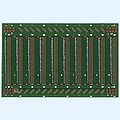Difference between revisions of "Schneiderware Basisplatine"
(Created page with "The Schneiderware series consists of several DIY projects which have been released in german magazine CPC Schneider International published by DMV. The name "Schneide...") |
|||
| (5 intermediate revisions by one other user not shown) | |||
| Line 1: | Line 1: | ||
| − | The [[Schneiderware]] | + | The [[Schneiderware Basisplatine]] (backplane) is some kind of a [[ECB Bus]] motherboard for the [[Schneiderware]] DIY series, which was published by german magazine [[CPC Schneider International]]. The board has five 64-pin ECB sockets (for use with the DIY boards of the series), a 50-pin connector (for the CPC expansion port), and 7 soldering points (for an optional power supply, like the [[Schneiderware Power Supply]]). |
| − | + | ||
| − | + | ||
| − | + | ||
| − | + | ||
| + | The plain PCB, or the fully assembled board were available via mail-order. Unlike as for the other DIY projects of the Schneiderware series, the PCB layout has not been printed (in paper-form) in the magazine (though the magazine offered to send them to interested persons). Another solution would have been to buy a standard ECB backplane (like [[:File:Reichelt Euro-Bus-Karte.jpg|this]]), and to build an adaptor for the CPC expansion port by hand. | ||
== Pictures == | == Pictures == | ||
| Line 12: | Line 9: | ||
File:Schneiderware 2 Basisplatine (component side).jpg|Basisplatine (component side) | File:Schneiderware 2 Basisplatine (component side).jpg|Basisplatine (component side) | ||
File:Schneiderware 2 Basisplatine (solder side).jpg|Basisplatine (solder side) | File:Schneiderware 2 Basisplatine (solder side).jpg|Basisplatine (solder side) | ||
| + | File:Reichelt Euro-Bus-Karte.jpg|Reichelt Euro-Bus-Karte (alternate solution) | ||
</gallery> | </gallery> | ||
| + | |||
| + | == Scanned Article == | ||
| + | |||
| + | * [[Media:Schneiderware 2 - Backplane and Centronics.pdf|Schneiderware 2 - Backplane and Centronics.pdf]] - Basisplatine and Printer Port - '''7/1986 page 60-67''', plus complaints from 10/1986 page 10, port B redefined on 12/1986 page 124 and 3/1987 page 8-9, final notes from 11/1987 page 98 | ||
| + | |||
| + | == References == | ||
| + | |||
| + | * [[ECB Bus]] | ||
| + | |||
| + | [[Category:Peripherals]] | ||
Latest revision as of 03:18, 29 August 2014
The Schneiderware Basisplatine (backplane) is some kind of a ECB Bus motherboard for the Schneiderware DIY series, which was published by german magazine CPC Schneider International. The board has five 64-pin ECB sockets (for use with the DIY boards of the series), a 50-pin connector (for the CPC expansion port), and 7 soldering points (for an optional power supply, like the Schneiderware Power Supply).
The plain PCB, or the fully assembled board were available via mail-order. Unlike as for the other DIY projects of the Schneiderware series, the PCB layout has not been printed (in paper-form) in the magazine (though the magazine offered to send them to interested persons). Another solution would have been to buy a standard ECB backplane (like this), and to build an adaptor for the CPC expansion port by hand.
Pictures
Scanned Article
- Schneiderware 2 - Backplane and Centronics.pdf - Basisplatine and Printer Port - 7/1986 page 60-67, plus complaints from 10/1986 page 10, port B redefined on 12/1986 page 124 and 3/1987 page 8-9, final notes from 11/1987 page 98



